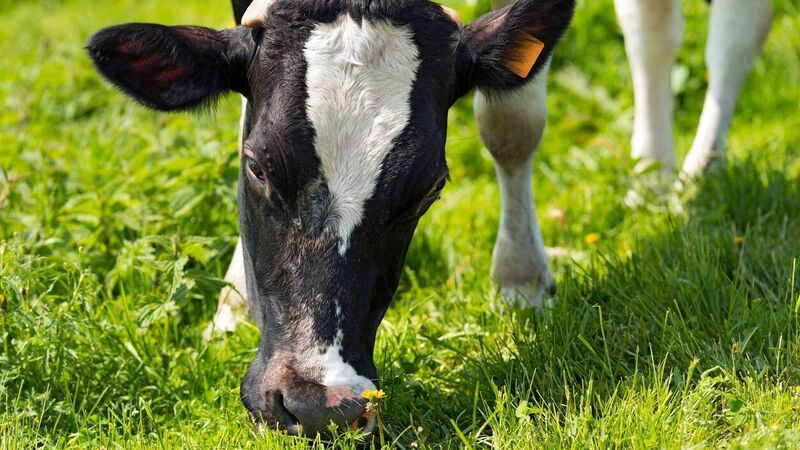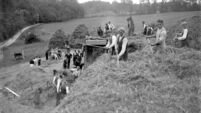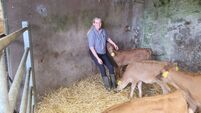Brian Reidy: Getting the balance right this May

Look at and listen to your cows. If solids are dropping, then energy and fibre intake is insufficient.
We are now well into the month of May and only in the last few days have we seen grass growth ramp up in any significant way. Already the country has supplied less milk than we had this time last year.
Why is this? As always there are many factors.
Let’s look at it from the cows' point of view. How much grass can a cow eat in a day? What is the quality of the grass? Does the weather affect the cows ability to maximise grass intake? What impacts how herds are fed?
Grass is the cheapest feed in Ireland for milk production. However, we must be prepared to take action due to its inconsistent nature depending on weather and growing conditions.
When grass is in good supply, many farmers can be tempted to reduce or even cease supplementary feeding. This can bring short-term improvements in margins. The cows will continue to milk satisfactorily and any small reductions in milk yield are generally accepted on the basis that margin per cow will be increasing due to the use of cheaper feed (pasture). However, some of these short-term gains may be hiding longer-term losses in performance.
Initially, the cow may continue to milk well, but this could often be at the expense of increased body tissue loss. In the best grazing conditions possible, when feeding no supplementary feed, grass intake is unlikely to exceed 18kg/day (approx. 3% of body weight).
There are, however, many situations when grazed pasture will not support more than 14kg DM intake/day, when grass quality, grass cover and weather are taken into account. Up until the end of April, grass proteins were much lower than normal at 18/19% and this can cause depressed dry matter intakes.
When you feed a concentrate when cows are on grass then grass intake is likely to decline (forage substitution rate) and the extra milk produced sometimes may be marginally economic (approx 1kg milk per kg of feed offered) or even uneconomic.
However, the nature of this response needs to be judged against wider issues including longer-term availability of pasture as well as improved body condition which may be possible when total energy intakes are increased through supplementary feeding.
Obviously the cost of concentrates this year has caused many to reduce or eliminate feed much earlier in the season than they normally would and this is very understandable, but may come at a cost down the line. If your herd are for example 2 litres lower than this day last year then they will potentially produce between 400 and 500 litres less for the rest of the current lactation.
Consider the above in the context of the last few weeks. For many farmers, early application of fertilizer had a lower than expected response. Coupled with the fact that because of the high fertiliser price, it was applied later and with fewer units per acre.
Growth was poor due to the weather as it was so cold and dry. What grass was available was eaten very quickly with little re-growth. The end of the 1st round was stretched out and even then the second round started with low covers This has resulted in cows grazing grass which is not ideal for milk and solid production as it was slightly strong and lower in energy and leaf content than we would like, followed by lower covers of softer grass where intakes have been harder to achieve.
All of a sudden, now with a jump in growth we will soon need to make decisions quickly to skip paddocks and wrap or pit them. In many cases, rotation length will need to be shortened in order to keep the grass being offered to cows at the optimum quality.
As mentioned above milk supply is down so far in 2022. This is due to a combination of things. However, if cows are milking below their potential then they are under pressure. Cows are bred to milk and even if they do not consume sufficient nutrients they will in most cases deplete their body reserves in order to try and maintain production.
If you are feeding the same level of concentrates to your cows at grass this year (with poorer grass quality) as you did last year and milk yield is the same, then cows are likely to be under a bit of pressure. Milk protein percentage is holding ok around the country this year as with lower yields there is less dilution.
Over the last month or so, I am hearing that a lot of cows are having silent heats, which is mostly due to lower energy intakes. Butter Fats are of concern currently in a lot of herds with 3.5 not uncommon. Butter Fat is driven by fibre digestion, so a drop is due to lower intakes of fibre or feed low in physical fibre content.
Grass recently as outlined above has gone from lower intakes in the first round to low fibre content in the second round.
Look at and listen to your cows. If solids are dropping, then energy and fibre intake is insufficient. This may be due to grass being too strong and of poorer quality or due to underfeeding of supplementation at grass. It may however be due to the too rapid throughput of grass through the cow’s digestive system.
In order for cows to maximize their production from grass, it needs to remain in the rumen long enough to be thoroughly digested. Keep an eye on dung consistency. Loose dung is not because of wet grass.
When dung is excessively loose it is generally due to low physical fibre levels in feed or an oversupply of protein. Remember that for a cow to function efficiently she must maximize cud-chewing activity in order to process her feed into milk. If she eats material which is soft or of small particle size then what will she chew on?
The addition of some straw at grass will supply this much needed physically effective fibre. On the issue of excessive protein supply, obviously, we haven’t seen the high levels of a normal spring/summer yet so is currently less of an issue.
Encouraging intakes with supplementation and providing fibre will help to address low Fats. There is also the issue of high CLA’s in grass swards at this time of the year where these oils coat the fibre and make it harder for the rumen bugs to digest it sufficiently. The inclusion of yeast in supplementation will also help with this issue.












